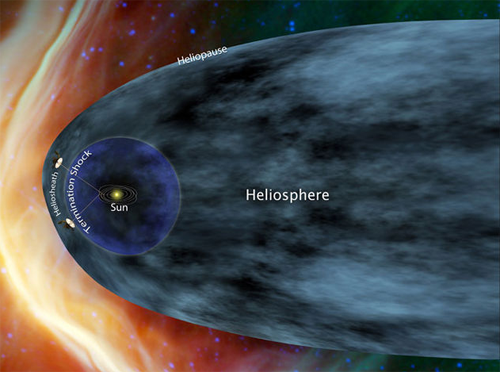There’s a double dose of news for space craft enthusiasts this week. Newly published analysis suggests Voyager 1 has hit one of its last milestones before exiting the solar system, while Amazon boss Jeff Bezos has succeeded in recovering two of the engines that helped launched man to the moon.
We’ve already covered the basics of Voyager 1 at GaS. Writing in 2010, we noted that it had entered the heliosphere, the point that’s further than any dwarf planets and consists largely of material blown out by the sun’s solar winds.
Within the heliosphere, Voyager 1 was known to be in the heliosheath. That’s the point where those solar winds slow down because they are affected by the interstellar medium (which is effectively what we mean by “outer space”.) Estimates suggest Voyager 1 will cross the heliopause (the outer border of the heliosphere) into the interstellar medium in 2015. That’s the big one as it means it will be completely out of our solar system and surrounded by material that has no connection whatsoever with our sun.
This week saw the publication of an article in Geophysical Research Letters by Bill Webber and Frank McDonald who have been looking through the data sent by Voyager (which takes 15 hours to arrive.) They reveal that on 25 August last year, the readings showed a sudden and significant fall in solar radiation and a corresponding rise in what are genuinely called “galactic cosmic rays.”
According to the writers, this means Voyager has passed what they call the heliocliff. It’s not the same as the heliopause, which is the end of the solar system’s influence. However, it does mark the point at which interstellar space has more influence than the solar system. Because the “spheres of influence” of the solar system and interstellar space overlap, this heliocliff is arguably the closest thing to a literal physical border.
Although the article is mainly written by Webber, he gave McDonald co-writing credit as a mark of respect. McDonald actually died just one week after Voyager appears to have passed the heliocliff.
NASA says the analysis matches up to its own figures and notes that it believes Voyager remains within the solar system. It adds that it won’t class Voyager as being in interstellar space until it records a change in the direction of the magnetic field, which hasn’t yet happened.
Meanwhile a team led and funded by Amazon’s Jeff Bezos has now recovered two of the five F-1 engines used in the first stage of launch in the Saturn V rockets used in the Apollo program. Bezos had found the engines last March, 14,000 feet below the surface of the Atlantic, after a lengthy sonar search.
Bezos now plans to restore the engines as best as possible. Although he acknowledges that NASA is the legal owner, based on his previous comments he’ll ask that one be displayed at the Smithsonian Institution’s Air and Space Museum and the other at Seattle’s Museum of Flight.

